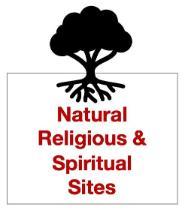
City parks, trails, urban lakes and streams, and undeveloped greenspace often have spiritual or religious significance for city residents and visitors, serving as sites for meditation, contemplation, prayer, and other religious or spiritual practices. While not formal religious sites—and, indeed, often valued precisely because they are not associated with institutional religions—these areas are often experienced as “sacred spaces.”
As with other categorizations, there can be some overlap. In this case, a city park like the Municipal Rose Garden, with its trees, roses, expansive lawns, and areas to rest and appreciate “nature” (even if cultivated) while listening to water gently fall in the fountain, provides an example of both a Public Religious & Spiritual Site or a Natural Religious & Spiritual Site. People studying living religion may emphasize one or the other function or they may explore how the two functions interact.